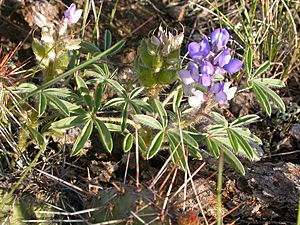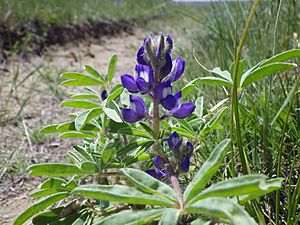Rusty lupine facts for kids
Quick facts for kids Rusty lupine |
|
|---|---|
 |
|
| Lupinus pusillus, Montana | |
| Scientific classification | |
| Genus: |
Lupinus
|
| Species: |
pusillus
|
Lupinus pusillus, also known as the rusty lupine or dwarf lupine, is a small plant that lives for only one year. It belongs to the pea family, called Fabaceae. You can find this plant growing in the southwestern United States, especially in places like the Colorado Plateau and Canyonlands region. It also grows further north, all the way to Montana.
Contents
Meet the Dwarf Lupine: What It Looks Like
How It Grows
The dwarf lupine is an annual plant. This means it completes its whole life cycle, from seed to flower to new seeds, in just one year. It can grow up to 9 inches (23 cm) tall. The name "pusillus" actually means "small," which perfectly describes this tiny plant.
Leaves and Stems
The leaves of the dwarf lupine are special. They are shaped like a hand with fingers spreading out, which is called palmate. Each leaf has 3 to 9 smaller parts called leaflets. These leaflets are about 1/2 to 1 1/2 inches (1.3 to 3.8 cm) long and are wider at the tip. Both the plant's main stems and the stems that hold the leaves (called petioles) are covered in long, soft hairs.
Flowers and Seeds
This plant blooms from April to June, showing off its pretty flowers. The flowers grow in tall stalks, with 4 to 38 flowers on each stalk. They are usually bluish to purple. Sometimes, they can even have two colors! You might spot a bright yellow spot on the top petal of the flower. After the flowers, the plant makes seedpods. These pods are almost oval-shaped and have little pinches that separate the seeds inside.
Where Does It Grow?
The dwarf lupine likes to live in dry places. You can find it in desert shrublands and pinyon juniper woodlands. These are areas with small bushes and trees like pine and juniper. Its range stretches from Washington state in the north, down through California, and all across the southwestern United States. When this lupine grows in reddish sand, its blue flowers look amazing, especially when the sun is low in the sky!
Who Visits the Lupine?
The dwarf lupine plays an important role in its environment. Its colorful flowers attract bees. Bees help the plant by carrying pollen from one flower to another, which allows the plant to make new seeds. This process is called pollination.


